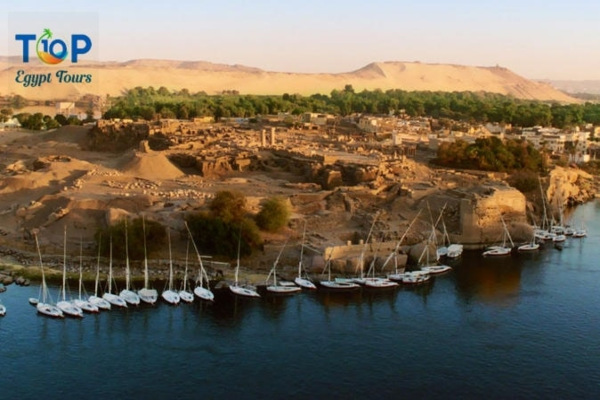The Elephantine Island Temple, also known as the Temple of Satet, is a well-preserved ancient Egyptian temple located on Elephantine Island in Aswan, Egypt. This magnificent temple complex offers a fascinating glimpse into the religious beliefs and architectural wonders of the ancient Egyptians.
In this article, we will uncover for you The Elephantine Island Temple with Top Ten Egypt.
The Elephantine Island Temple: Dedication to Goddess Satet:
Dedicated to the goddess Satet, who represents the Nile River and fertility, the Elephantine Island Temple holds great significance in the ancient Egyptian pantheon. Built during the Middle Kingdom and expanded in the New Kingdom, this temple complex consists of a main temple, a smaller temple, and several other structures. Satet, depicted in reliefs throughout the temple, is accompanied by other Egyptian deities, and inscriptions narrate her story and importance to the Egyptian people.
The Smaller Temple and Khnum:
Within the complex, a smaller temple is dedicated to Khnum, the ram-headed god of creation. Intricately adorned with reliefs depicting Khnum and various gods and goddesses, this temple adds to the religious significance of the site. Together, the main temple and the smaller temple offer a comprehensive understanding of ancient Egyptian religious practices.
Archaeological Significance:
The Elephantine Island Temple stands as a significant archaeological site, providing invaluable insights into ancient Egyptian culture. Visitors can marvel at the well-preserved architecture and artistic reliefs, gaining a deeper appreciation for the religious customs and beliefs of this ancient civilization. The temple complex is a testament to the architectural brilliance of the time and serves as a window into the past.
Exploring the Temple:
Accessible by boat from Aswan, the temple complex welcomes visitors to immerse themselves in its rich history. Knowledgeable tour guides are available to provide detailed explanations and share the temple’s historical and cultural significance. Exploring the complex allows visitors to witness the grandeur of the main temple, admire the beauty of the smaller temple, and discover additional structures like the Nilometer, library, and hospital.
Fascinating Facts:
- Strategic Location: The temple’s position overlooking the First Cataract of the Nile River gave it a crucial role in trade and commerce.
- A Place of Worship: The temple was an important religious center where worshippers sought the blessings of Satet.
- Additional Buildings: The complex includes a Nilometer, used to measure the Nile’s water levels, a library, and a hospital, highlighting the multifaceted nature of this ancient site.
- Archaeological Excavation: The temple was meticulously unearthed by archaeologists from the Egypt Exploration Society in the late 19th and early 20th centuries.
- Popular Tourist Destination: The Elephantine Island Temple is renowned for its exceptional preservation and attracts tourists from around the world, making it a must-visit destination for history enthusiasts.
Conclusion:
The Elephantine Island Temple, with its dedication to the goddess Satet and its architectural splendor, offers a captivating journey into the ancient Egyptian civilization. As visitors explore the well-preserved complex, they gain a deeper understanding of the religious beliefs and practices of the time. This remarkable archaeological site stands as a testament to the enduring legacy of Egypt’s remarkable cultural heritage and continues to inspire awe and admiration among all who visit.
Browse our complete list of Egypt tours



Comment (0)